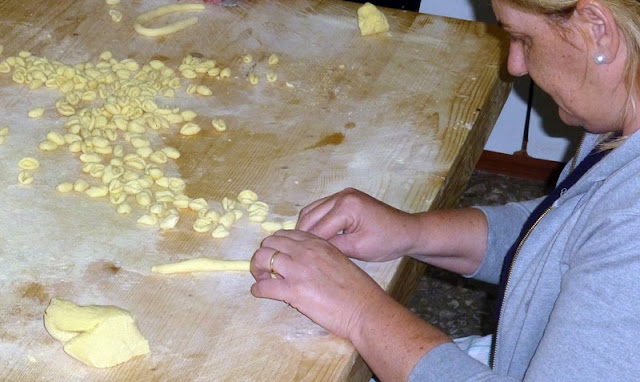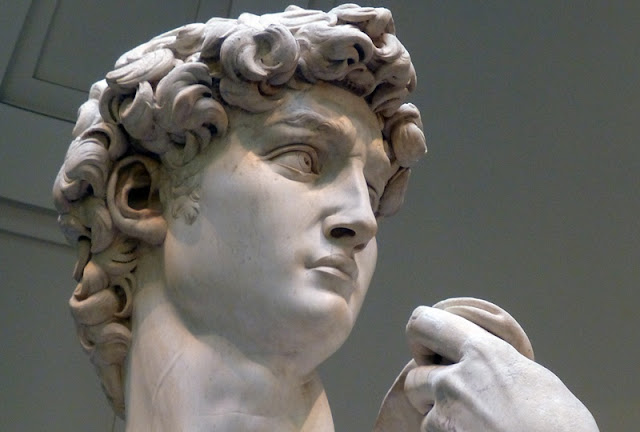Tuesday, October 20, 2015
Florence
A day so full that Haim faced a rebellion at the end, but
that’s a story yet to come.
We awoke at 6:30, not fully rested, and at 8:00 began our
walk to the Galleria della Accademia. Despite
having timed tickets, there was a very long line, so, putting on our earpieces,
we had a study session while we stood in line to get in, focusing on Boccaccio’s
Decameron, specifically “Day The First Abraham the Jew, at the Instigation of
Jehannot de Chevigne, Goeth to the Court of Rome and, Seeing the Depravity of
the Clergy, Returneth to Paris and There Becometh a Christian.” It’s a wonderful tale, and there’s much to
discuss and think about.
Ultimately we entered, and began a tour with our guide,
starting with the astonishing “Rape of the Sabine Women” from 1856 by
Giambologna:
We next toured the Instrument Museum section, full of beautiful
instruments, none of which are ever played.
This includes a Stradivarius violin which has never been played. To me this is a travesty. These instruments are made to be heard not to
be looked at, and keeping them as specimens to view violates their
purpose. Our Smithsonian, for example,
has a complete quartet of Stradivarius instruments which are constantly loaned
out to be heard. That’s not the philosophy
here, however.
We next went to see the Michelangelo David. We had a delightful lecture on the David from
our guide, and there’s much to learn.
David, of course, is now indoors, but originally he was where there is
now a copy in the Piazza della Signora, and the gaze which now simply looks
away, originally faced Rome, the traditional Florentine rival. David here is portrayed as a Greek god, and
there’s lots to be thought about when combining the bible story and the goal of
Michelangelo. The statue is magnificent:
After finishing our tour of the Galleria, we walked to the
synagogue:
We had a tour of the synagogue, built in 1882 in Moorish
style, with a Byzantine basilica form, after the lifting of the restrictions on
Jewish life. It was done in such a way
as to reflect the assimilation of Jews into Florentine life. The Aron Chodesh is enormous, and held 130
Torahs which dated from the 15th to the 17th c.
We walked the streets of the Florence ghetto, and standing
on a street corner at the entrance to the ghetto we reflected on the relationship
of the Mecicis and the Jews of Florence.
It was complicated and quite up and down. This plaque was in our study book:
COSIMO DEI MEDICI, GRAND DUKE OF
TUSCANY
AND HIS SON THE MOST SERENE PRINCE
FRANCESCO
MOTIVATED IN ALL THINGS BY GREAT
PIETY
WILLED THAT THE JEWS BE ENCLOSED IN
THIS PLACE
SEGREGATED FROM THE CHRISTIANS BUT
NOT EXPELLED
SO THAT THROUGH GOOD EXAMPLE THEY
MIGHT COME
TO BOW THEIR STUBBORN NECKS TO
CHRIST'S LIGHT YOKE
YEAR OF THE LORD 1571
We discussed what it meant to be segregated but not
expelled. We next walked back to the
Duomo for a tour of the 13th c. cathedral:
There are so many treasures inside that choosing what to
show is difficult. Here is a mosaic of
the crowning of Mary from 1300:
Interestingly, the walls are devoted to famous Florentines,
not to saints. Here’s Dante:
And the decorations reflect the works of those
memorialized. Here’s a descent into hell
on a ceiling:
We next walked to the Palazzo Vecchio, the secular heart of
the city and the place where the city government was housed:
In front is a statue of Neptune, another reflection of the
fascination of Renaissance Florence with the Roman past:
In the Palazzo we studied the proclamations which are in the
city archives from August 27, 1463.
These included a number of regulations concerning the Jews, such as this
one:
All Jews whatsoever, male and
female, more than twelve years of age, included or not included in the Condotta
with the city of Florence, and whether they reside in the city of Florence or
not, are required to wear within the City of Florence the sign of
"O"-that is, a large yellow "O" on their garments over the
left side of their chest so that it might be readily seen, and that such
distinctive sign must be at least a third of a cubit in circumference, and at
least a finger in thickness, under pain of ....
And:
Jews are permitted to keep, read, study and
copy their sacred books and books of science of whatever sort [libri di scienza
di qualunche ragione si fussino] except those infamous and condemned writings
[infamati et incolpati] of the community of Cortona, or any books against the
Christian faith.
Finally we climbed up to the fourth floor of the palace and
were able to have a great view of the city from a balcony there. At this point, 5:15 PM, Haim began another
lecture, this one on the resolution of conflicts between the Levantine Jews and
the Italian Jews in the civil courts.
Members of our group were sprawled on the floor, leaning on posts,
dozing standing up, and about two of us were able to pay attention. It was time to quit for the day, and in as
gentle a way as we could, we told Haim he had lost us. He looked around, somewhat surprised, as I
think his energy is so amazing that he doesn’t realize the rest of us are ordinary
mortals. We ended our day and staggered
back to the hotel.


















































